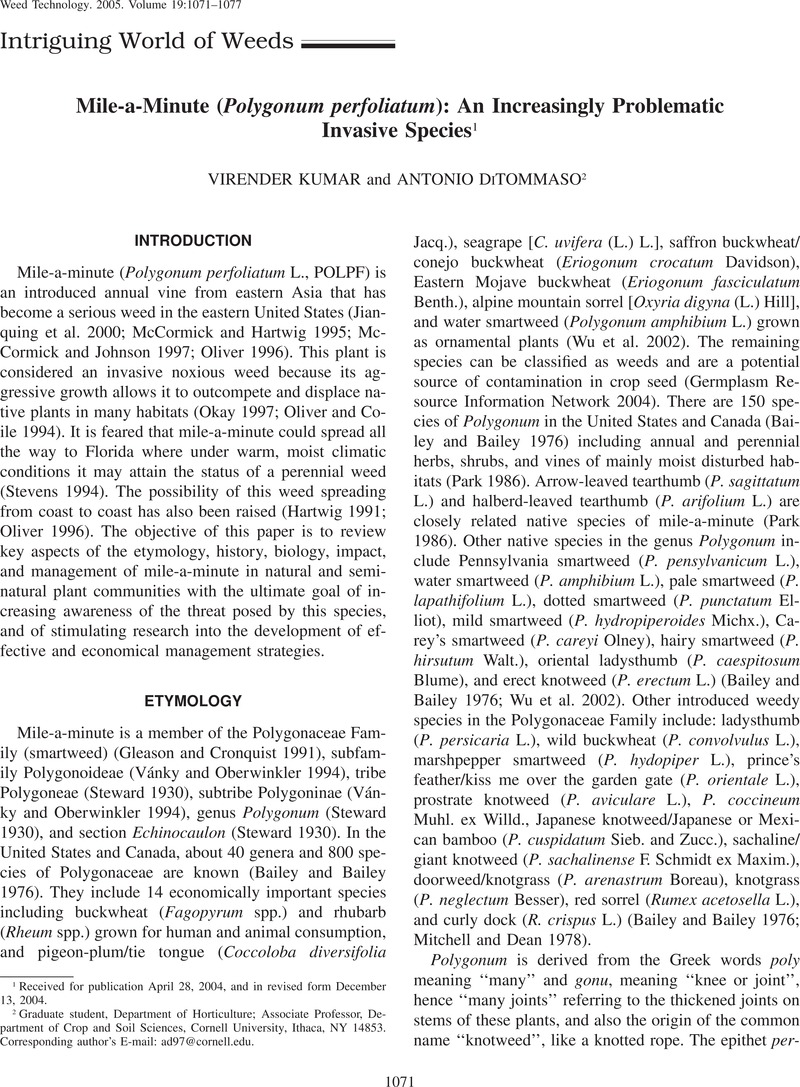Crossref Citations
This article has been cited by the following publications. This list is generated based on data provided by Crossref.
Burnham, Robyn J.
2008.
Hide and Go Seek: What Does Presence Mean in the Fossil Record.
Annals of the Missouri Botanical Garden,
Vol. 95,
Issue. 1,
p.
51.
LI, R H
and
QIANG, S
2009.
Composition of floating weed seeds in lowland rice fields in China and the effects of irrigation frequency and previous crops.
Weed Research,
Vol. 49,
Issue. 4,
p.
417.
Brundu, G.
Aksoy, N.
Brunel, S.
Eliáš, P.
and
Fried, G.
2011.
Rapid surveys for inventorying alien plants in the Black Sea region of Turkey.
EPPO Bulletin,
Vol. 41,
Issue. 2,
p.
208.
Guo, Wen‐Feng
Zhang, Jun
Li, Xiao‐Qiong
and
Ding, Jian‐Qing
2011.
Increased reproductive capacity and physical defense but decreased tannin content in an invasive plant.
Insect Science,
Vol. 18,
Issue. 5,
p.
521.
Guo, Wenfeng
Li, Xiaoqiong
Guo, Xiaohui
and
Ding, Jianqing
2011.
Effects ofRhinoncomimus latipeson the growth and reproduction ofPersicaria perfoliata,an invasive plant in North America.
Biocontrol Science and Technology,
Vol. 21,
Issue. 1,
p.
35.
Steffen, K.
Schrader, G.
Starfinger, U.
Brunel, S.
and
Sissons, A.
2012.
Pest risk analysis and invasive alien plants: progress through PRATIQUE*.
EPPO Bulletin,
Vol. 42,
Issue. 1,
p.
28.
Smith, Jeffrey R.
and
Hough-Goldstein, Judith
2013.
Phototaxis, Host Cues, and Host-Plant Finding in a Monophagous Weevil, Rhinoncomimus latipes.
Journal of Insect Behavior,
Vol. 26,
Issue. 1,
p.
109.
Breen, Daniel B.
Beauchamp, Vanessa B.
Koontz, Stephanie M.
and
Roberts, Roland P.
2015.
The Influence of Agricultural Abandonment and the Abiotic Environment on the Vegetation Communities of a Suburban Deciduous Forest.
Castanea,
Vol. 80,
Issue. 2,
p.
103.
Simmons, Brady L.
Hallett, Richard A.
Sonti, Nancy Falxa
Auyeung, D. S. N.
and
Lu, Jacqueline W. T.
2016.
Long‐term outcomes of forest restoration in an urban park.
Restoration Ecology,
Vol. 24,
Issue. 1,
p.
109.
Miller, William R.
Connolly, Bryan A.
and
Cygan, Douglas
2018.
A New Record of Invasive Mile-A-Minute VinePersicaria perfoliata(Polygonaceae) In New Hampshire.
Rhodora,
Vol. 120,
Issue. 982,
p.
179.
Cheah, Carole A. S-J.
and
Ellis, Donna R.
2019.
SPREAD OF MILE-A-MINUTE VINE, PERSICARIA PERFOLIATA L. (POLYGONACEAE) TO CONNECTICUT ISLANDS IN LONG ISLAND SOUND.
Rhodora,
Vol. 121,
Issue. 987,
p.
219.
Shi, Peijian
Liu, Mengdi
Ratkowsky, David A.
Gielis, Johan
Su, Jialu
Yu, Xiaojing
Wang, Ping
Zhang, Lifang
Lin, Zhiyi
and
Schrader, Julian
2019.
Leaf area–length allometry and its implications in leaf shape evolution.
Trees,
Vol. 33,
Issue. 4,
p.
1073.
Kim, Jaewon
Huebner, Cynthia D
Reardon, Richard
Park, Yong-Lak
and
Moses-Gonzales, Nathan
2021.
Spatially Targeted Biological Control of Mile-a-Minute Weed Using Rhinoncomimus latipes (Coleoptera: Curculionidae) and an Unmanned Aircraft System.
Journal of Economic Entomology,
Vol. 114,
Issue. 5,
p.
1889.
Kim, Jaewon
Huebner, Cynthia D.
and
Park, Yong-Lak
2021.
Plant Species Composition and Interactions within Communities Invaded by Persicaria perfoliata (Polygonaceae).
Northeastern Naturalist,
Vol. 28,
Issue. 3,
Ding, Jianqing
2022.





